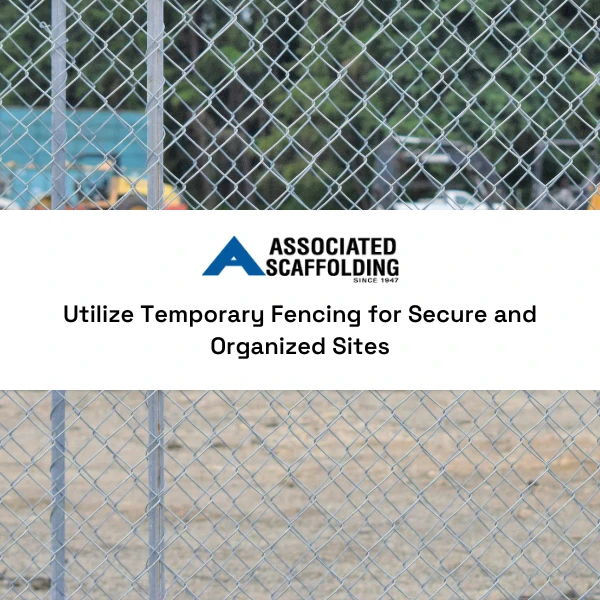Securing the Site: A Guide on Effectively Using Temporary Fencing for Construction Safety
As construction sites continue to transform city skylines and shape the built environment, the need for effective safety measures becomes more pronounced than ever. Temporary fencing for construction stands as a dynamic and versatile solution, serving as more than just a boundary line—it’s a key player in fostering secure environments, controlling access, and mitigating potential hazards.
Let’s delve into the multifaceted world of temporary fencing within the construction industry, exploring its diverse types, applications, and the crucial role it plays in ensuring the well-being of workers, the public, and the success of construction projects.

How to Use Temporary Fencing for Construction Safety
Setting up temporary fencing for construction projects requires teams to take into account a few key factors.
Establishing a Secure Perimeter
One of the primary functions of temporary fencing for construction sites is to establish a secure perimeter. This serves as a visual and physical barrier, demarcating the boundaries of the construction area. A well-defined perimeter prevents unauthorized access, reduces the risk of accidents, and ensures the safety of both workers and the public.
Controlling Access Points
Temporary fencing allows for the strategic placement of access points, enabling controlled entry and exit from the construction site. By designating specific areas for traffic going in and out, construction managers can monitor and regulate the flow of workers, equipment, and materials, enhancing overall safety and organization.
Preventing Unauthorized Entry
Unauthorized entry poses a significant risk on construction sites. Temporary fencing for construction acts as a deterrent, discouraging trespassers and minimizing the likelihood of theft, vandalism, or accidents caused by untrained individuals entering restricted areas. The presence of fencing sends a clear message about the importance of safety protocols.
Enhancing Public Safety
Construction sites are often in proximity to public spaces. Temporary fencing for construction plays a crucial role in protecting the public by preventing inadvertent access to potentially hazardous areas. This proactive measure contributes to a safer environment for both construction activities and the surrounding community.
Creating Safe Zones
Temporary fencing for construction allows for the creation of designated safe zones within the construction site. These areas can be used for breaks, meetings, or storing materials, ensuring workers have dedicated spaces free from construction hazards. This contributes to a more organized and safety-conscious work environment.
Customizing Fencing Solutions
Construction sites vary in size, layout, and potential risks. Temporary fencing comes in various types, including chain-link, mesh, or barricade fencing, and can be customized to suit the site’s specific needs. Tailoring the fencing solution ensures optimal effectiveness in addressing each construction project’s unique safety challenges.
Incorporating Signage
Temporary fencing for construction sites provides a valuable space for safety signage. Clearly displaying warnings, directions, and contact information enhances communication and reinforces safety protocols. Proper signage serves as a visual reminder of potential risks and the importance of adhering to safety guidelines.
Considering Environmental Impact
Temporary fencing can be a sustainable choice if its environmental impact is considered. Opting for reusable or recyclable materials contributes to eco-friendly construction practices. This aligns with the growing emphasis on sustainability within the construction industry.
How to Choose the Right Temporary Fencing for Construction
Before you can install your temporary fencing, you’ll want to be sure you are picking the right type. There are a few different kinds of temporary fencing, each designed to address specific construction site needs.
Chain-Link Fencing
Chain-link fencing is a popular choice for construction sites due to its durability, versatility, and ease of installation. These fences consist of interwoven metal links, providing a sturdy and secure barrier. Chain-link fencing is effective for establishing perimeters, controlling access, and ensuring visibility within the construction site.
Mesh Fencing
Mesh fencing, often made of woven fabric or plastic, offers a lightweight and flexible solution. It is ideal for creating quick enclosures, defining work zones, and preventing debris from spreading beyond the construction site. Mesh fencing allows for airflow and visibility while providing a level of containment.
Barricade Fencing
Barricade fencing is a robust and interlocking solution that provides both security and stability. These fences are easily stackable and can be arranged to create secure barriers around hazardous areas. Barricade fencing is suitable for controlling crowds, redirecting traffic, and securing construction zones effectively.
Construction Safety Barriers
Specifically designed for construction sites, safety barriers often include reflective elements for increased visibility. They are also portable and easily deployable, making them versatile for creating safe zones, guiding traffic, and delineating potential hazards.
Concrete Barriers
Concrete barriers are heavy-duty solutions designed for enhanced security and impact resistance. They effectively protect against vehicle intrusion, safeguard critical infrastructure, and create sturdy perimeters in high-security construction areas.
Plastic Fencing
Plastic fencing is a lightweight and weather-resistant option suitable for various construction applications. It is easy to install, reusable, and often incorporates interlocking features for stability. Plastic fencing is ideal for short-term projects and situations where mobility and quick setup are essential.
Privacy Screening
Privacy screening, often added to chain-link or mesh fencing, provides an additional layer of concealment. It enhances security and helps mitigate the visual impact of construction activities on the surrounding community.
Final Word: How to Use Temporary Fencing for Construction Safety
By establishing secure perimeters, controlling access points, preventing unauthorized entry, enhancing public safety, creating safe zones, customizing solutions, and incorporating signage, construction professionals can leverage temporary fencing to effectively mitigate risks and ensure a secure and organized work environment.
As a pioneer in scaffolding sales, rentals, and safety services, Associated Scaffolding consistently prioritizes safety. Our dedication to maintaining high standards is resolute, whether we are supplying materials or delivering comprehensive training and education.
Feel free to reach out to us today to discover more about our offerings and how we can support your safety needs!


